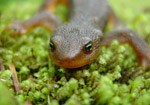
AmphibiansWalk through a rain forest valley on a damp spring day and look around at the mossy forest floor, or under the abundant, decaying downed trees. You may spot an amphibian. The ponds, lakes, streams and forests of Olympic National Park provide the ideal habitat for frogs, toads, newts, and salamanders. Some, like the rough-skinned newt, which sports a bright orange belly and bumpy brown skin, are common in the lowlands. Others, like the tailed frog, can live in cold, rushing mountain streams. Olympic is home to one endemic (found only locally) species, the Olympic Torrent Salamander (Rhyacotriton olympicus). Throughout the world, many amphibian populations are declining. Though research has revealed Olympic seems to have fairly stable populations of most species, western toads could be declining. With life histories that include life in air and water, amphibians are susceptible to pollution from both sources, as well as being vulnerable to predation by introduced non-natives like bull frogs and eastern brook trout. ReptilesThe cool, maritime climate in Olympic National Park is not ideal for reptiles. Nevertheless, there are some snakes and lizards that have been documented in the park. There are no venomous snakes on the Olympic Peninsula. Off-shore there are several species of sea-turtle that are at home in our ocean waters. Sometimes these turtles strand on the shoreline. If you should find such a turtle please report it via email to e-mail us. Species InventoryRead the park's 2003 inventory report on Olympic National Park amphibian and reptile inventory, with emphasis upon terrestrial herpetofauna (1999-2001). Select a Park:Select a Species Category (optional):
Search results will be displayed here.

Amphibians & Reptiles in National Parks
A Northwest Salamander on a cushion of moss. 
Ethical Wildlife Viewing
Animals in parks are wild—Visitors are responsible for their own safety and for the safety of the animals, too. 
Wildlife and Natural Processes
Learn more about how Wildness, or natural processes, are an important part of Olympic National Park. |
Last updated: July 3, 2025
